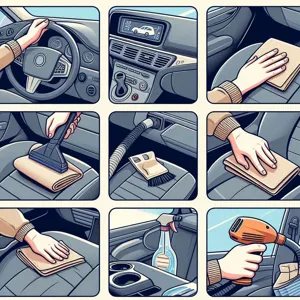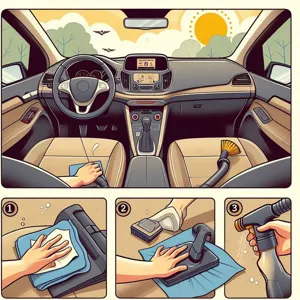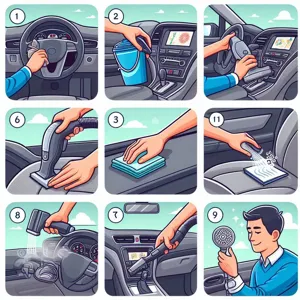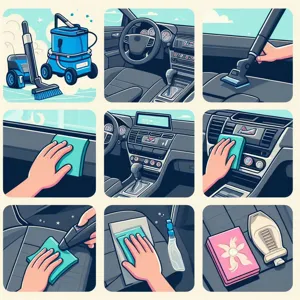In a world where fuel prices seem to soar higher with each passing day, finding ways to maximize your car’s fuel economy has never been more essential.
Whether you’re a daily commuter, a weekend road tripper, or someone who simply wants to get the most out of their vehicle, understanding how to enhance fuel efficiency can lead to significant savings and a lighter environmental footprint. In this blog post, we’ll explore ten proven tips that are not only easy to implement but can also lead to noticeable improvements in your car‘s mileage. From simple maintenance checks to smart driving habits, these strategies will empower you to take control of your fuel consumption and make every gallon count. Say goodbye to frequent gas station stops and hello to a more efficient, budget-friendly driving experience!
1. Understanding Fuel Economy: Why It Matters

Understanding fuel economy is more important than ever in today’s world, where fluctuating gas prices and environmental concerns are at the forefront of many drivers’ minds. Fuel economy, typically expressed in miles per gallon (MPG), measures how efficiently your vehicle converts fuel into distance traveled. It’s not just about saving a few bucks at the pump; it’s also about reducing your carbon footprint and contributing to a healthier planet.
Improved fuel economy translates to fewer trips to the gas station and more money in your pocket, which can be a game-changer for your budget. It means you can enjoy those spontaneous road trips without the constant worry of rising fuel costs cutting into your plans. Moreover, with the growing emphasis on sustainability, driving a vehicle that maximizes fuel efficiency aligns with a more eco-conscious lifestyle.
Understanding how various factors—such as driving habits, vehicle maintenance, and even the type of fuel you use—can affect your fuel economy allows you to make informed decisions that benefit both your wallet and the environment. By prioritizing fuel efficiency, you’re not only ensuring that your car runs optimally, but you’re also becoming part of a larger movement towards sustainable transportation. Embracing fuel economy is a win-win situation that ultimately leads to a more enjoyable and responsible driving experience.
2. Tip 1: Maintain Proper Tire Pressure
Maintaining proper tire pressure is one of the simplest yet most effective ways to enhance your car’s fuel economy. Under-inflated tires create more rolling resistance, which forces your engine to work harder and consume more fuel. Conversely, over-inflated tires can lead to uneven wear and a harsher ride, compromising safety and comfort.
To ensure optimal tire pressure, it’s crucial to check your tires regularly—ideally once a month and before long trips. Most vehicles have a recommended tire pressure listed in the owner’s manual or on a sticker located inside the driver’s side door. Use a reliable tire pressure gauge to measure each tire’s inflation level when they are cold, as heat from driving can artificially inflate the readings.
Keeping your tires properly inflated not only maximizes fuel efficiency but also extends the life of your tires, improving overall vehicle performance. Additionally, well-maintained tires provide better traction, ensuring safer handling on the road. By dedicating just a few minutes each month to this essential maintenance task, you can enjoy a smoother ride, enhance your car’s fuel economy, and save money at the pump. It’s a small investment of time that yields significant returns.
3. Tip 2: Keep Your Engine Well-Tuned

A well-tuned engine is the heart of your vehicle, directly influencing its performance and fuel efficiency. Just like a finely tuned musical instrument, your car’s engine needs regular care and attention to operate at its best. When your engine is running smoothly, it not only extends the life of your vehicle but also enhances its fuel economy significantly.
Regular maintenance is key. This includes routine oil changes, replacing air filters, and checking spark plugs. When you keep your engine oil clean and at the proper level, it reduces friction between moving parts, allowing your engine to run more efficiently. Likewise, changing your air filter regularly ensures that your engine receives a steady flow of clean air, which is essential for optimal combustion.
Another critical aspect of engine tuning is ensuring that your fuel injectors are clean and functioning correctly. Clogged or malfunctioning injectors can lead to poor fuel atomization, causing your engine to burn more fuel than necessary and resulting in decreased fuel economy. Consider using fuel additives occasionally to help clean your fuel system and maintain optimal performance.
Additionally, keeping an eye on your vehicle’s diagnostic system can help you catch potential engine issues before they escalate. Many modern cars come equipped with onboard diagnostics that can alert you to problems such as misfires or inefficient fuel usage. Addressing these issues promptly can save you money at the pump and prevent more extensive repairs down the line.
In summary, a well-tuned engine is essential for achieving the best possible fuel economy. By committing to regular maintenance and addressing any issues as they arise, you can ensure that your vehicle operates efficiently, allowing you to enjoy longer drives with fewer stops at the gas station.
4. Tip 3: Use the Recommended Motor Oil
Using the recommended motor oil for your vehicle is a simple yet often overlooked tip that can significantly enhance your car’s fuel economy. Each vehicle is engineered with specific requirements, and the manufacturer specifies the type and viscosity of motor oil that works best for optimal performance. Selecting the appropriate oil not only ensures that your engine runs smoothly but also promotes efficient fuel usage.
When you use the right motor oil, you minimize engine friction, allowing your engine to operate more efficiently. This efficiency translates to less energy wasted, which means your car doesn’t have to work as hard to maintain speed or acceleration. Additionally, high-quality synthetic oils often contain additives that help to clean engine components and reduce deposits, further enhancing performance and fuel efficiency.
To find the motor oil recommended for your car, check the owner’s manual or consult with a professional mechanic. Pay attention to the viscosity rating, typically denoted by a grading system like 5W-30 or 10W-40, which indicates how well the oil flows at different temperatures. Investing in the right oil may cost a bit more upfront, but the long-term benefits of improved fuel economy and engine longevity are well worth it.
Moreover, remember to change your oil regularly as per the manufacturer’s guidelines. Old or contaminated oil can lose its effectiveness, leading to increased friction and reduced fuel economy. By staying proactive and using the recommended motor oil, you can take a significant step towards maximizing your car’s fuel efficiency and enjoying longer drives with fewer stops at the pump.
5. Tip 4: Adopt Smooth Driving Habits
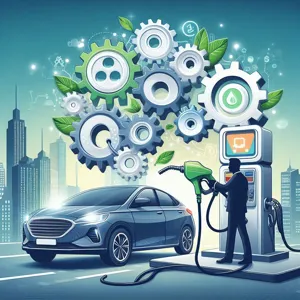
Adopting smooth driving habits can significantly enhance your car’s fuel economy, and it’s easier than you might think. Picture the difference between a serene glide down the highway and a jerky, stop-and-go commute. The former not only feels more enjoyable but also translates to substantial fuel savings.
When you accelerate gently and anticipate traffic conditions, you can maintain a steady speed, which is key to maximizing efficiency. Quick, aggressive acceleration consumes more fuel than a gradual increase in speed. Similarly, hard braking can lead to increased fuel consumption, as it often requires you to speed up again. Instead, aim to coast to a stop whenever possible. This simple shift in approach can help you save fuel and extend the life of your brakes.
Using cruise control on the highway can also contribute to smoother driving. By maintaining a constant speed, you reduce the likelihood of fluctuations in acceleration that can lead to unnecessary gas usage. Additionally, keeping a safe following distance allows you to react smoothly to changes in traffic, further conserving fuel.
Lastly, consider limiting your use of air conditioning and other electrical accessories, as these can strain your engine and reduce fuel efficiency. When combined with other eco-friendly driving techniques, such as reducing idling time and planning your trips to avoid heavy traffic, adopting smooth driving habits can lead to significant improvements in your car’s fuel economy. Not only will your wallet thank you, but your vehicle will likely perform better in the long run!
6. Tip 5: Reduce Excess Weight in Your Vehicle
Every extra pound in your vehicle can make a noticeable difference in fuel efficiency. It’s a simple yet often overlooked factor that can significantly impact your car’s performance and economy. To put it into perspective, studies suggest that for every 100 pounds of extra weight, your vehicle’s fuel efficiency could decrease by up to 1%. This might not seem like much on the surface, but over time, especially with frequent short trips or in stop-and-go traffic, that can add up to a significant waste of fuel.
Begin by doing a thorough inventory of your vehicle. Clear out the clutter—remove any unnecessary items that have found their way into your trunk or backseat. Those sports equipment bags, old tools, and even the extra set of golf clubs you swear you’ll use can all contribute to extra weight.
Next, consider the permanent fixtures in your car. If you frequently carry items like roof racks or heavy towing equipment that you rarely use, removing them when not needed can also help lighten the load. Additionally, if your vehicle has a third-row seat that you rarely utilize, consider folding it down or removing it entirely if possible.
Not only does reducing excess weight improve your fuel economy, but it can also enhance your vehicle’s handling and braking performance. A lighter car accelerates more quickly and stops more effectively, providing a safer driving experience. So, take a moment to lighten your load—your wallet and your car will thank you!
7. Tip 6: Optimize Your Air Conditioning Use

Optimizing your air conditioning use can significantly influence your car’s fuel economy, especially during those sweltering summer months. While it might be tempting to crank up the AC to escape the heat, doing so can lead to increased fuel consumption. Air conditioning systems draw power from the engine, and this demand can cause your vehicle to use more fuel.
One effective strategy is to balance comfort with efficiency. When driving at lower speeds, consider rolling down the windows instead of using the AC. The natural airflow can cool you down without the added fuel cost. However, once you hit the highway and your speed increases, it’s often more fuel-efficient to close the windows and rely on the AC. This is because open windows can create drag, reducing your vehicle’s aerodynamics.
Additionally, using the AC wisely can make a difference. Start by turning on your car’s ventilation system and allowing the hot air to escape before activating the air conditioning. This approach cools the cabin more quickly, reducing the time the AC has to run at full power.
Moreover, regularly maintaining your air conditioning system is crucial. A well-maintained AC unit operates more efficiently, thus consuming less fuel. Ensure that your system is serviced regularly, and replace any clogged filters to maximize airflow.
By being mindful of how and when you use your air conditioning, you can enjoy a cooler ride while also enhancing your car’s fuel economy. Implement these adjustments, and you may find yourself saving both fuel and money on those long summer drives!
8. Tip 7: Plan Your Trips Efficiently
Planning your trips efficiently is crucial for maximizing your car’s fuel economy. By taking a little time to strategize your routes and schedules, you can significantly reduce unnecessary mileage and fuel consumption. Start by mapping out your destinations and identifying the most direct routes. Use navigation apps that provide real-time traffic updates to avoid congested areas and roadwork, which can lead to idling and excessive fuel usage.
Consider combining errands into a single trip rather than making multiple short journeys. This not only saves fuel but also minimizes wear and tear on your vehicle. For instance, instead of driving back and forth to the grocery store, the post office, and the gym throughout the week, plan a single outing that includes all these stops.
Timing your trips can also make a difference. Aim to travel during off-peak hours when traffic is lighter, allowing for smoother driving and less stop-and-go congestion. If you’re heading out for a longer journey, try to leave early in the morning or later in the evening to avoid midday heat and traffic jams.
Lastly, don’t forget to consider the weather. On cold days, for example, your car’s engine works harder, consuming more fuel. If possible, wait for milder weather to run errands or group your trips on warmer days. By being mindful of when and how you travel, you can enhance your car’s fuel efficiency and keep more money in your pocket.
9. Tip 8: Limit Idling Time
### 9. Tip 8: Limit Idling Time
One of the most overlooked factors affecting your car’s fuel economy is idling time. Many drivers are unaware that their vehicles consume fuel even when they are stationary, simply idling in a parking lot or waiting for a friend to hop in. In fact, idling can waste more fuel than you might think!
When your engine is running without moving the car, it continues to burn fuel unnecessarily, leading to reduced miles per gallon (MPG) and higher emissions. The U.S. Department of Energy estimates that idling can consume a quarter to a half gallon of fuel per hour, depending on the size of your engine and the conditions.
So, what can you do? If you find yourself stopped for more than a minute or two—perhaps waiting in a drive-thru line or sitting in traffic—consider turning off your engine. Not only will this save fuel, but it will also reduce wear and tear on your vehicle’s engine and exhaust system.
For those who drive in urban areas where stoplights and traffic frequently disrupt flow, investing in a car with automatic start-stop technology may be worth considering. This feature automatically shuts off the engine when the vehicle is at rest and seamlessly restarts it when you’re ready to move, ensuring you’re not wasting fuel during those inevitable stops.
Additionally, educate those around you about the benefits of limiting idling. If your friends or family are waiting in the car, encourage them to turn off the engine while they wait. By adopting this simple habit, you can collectively contribute to better fuel economy and a healthier environment.
By being mindful of your idling time, you’ll not only extend the life of your vehicle, but you’ll also see a noticeable improvement in your fuel economy, keeping more money in your pocket for what really matters—enjoying the open road!
10. Tip 9: Use Cruise Control on Highways
Using cruise control on highways is a simple yet effective strategy to enhance your vehicle’s fuel economy. When you’re cruising down the open road, maintaining a steady speed becomes crucial, and that’s where cruise control shines. By automating your speed, this feature helps eliminate the tendency to accelerate or decelerate unnecessarily, which can lead to increased fuel consumption.
Imagine gliding along a stretch of highway, your car maintaining a consistent speed without your foot hovering over the gas pedal. This steadiness not only reduces the strain on your engine but also minimizes the amount of fuel consumed. Studies have shown that using cruise control can improve fuel efficiency by approximately 7% to 14% on long highway drives, depending on your speed and driving conditions.
Additionally, cruise control helps you avoid the common pitfall of aggressive driving habits, such as sudden accelerations and hard braking, which can sap your fuel reserves faster than you might realize. By giving your foot a break, you’re allowing your vehicle to operate more efficiently and smoothly, translating to fewer stops at the gas station.
However, it’s essential to use cruise control wisely. It’s best suited for long, flat highway stretches rather than winding roads or busy urban areas where frequent speed changes are necessary. By incorporating cruise control into your driving routine, you not only enjoy a more relaxed ride but also contribute to better fuel economy, making it a win-win for both your wallet and the environment. So, the next time you hit the highway, set your cruise control and watch your fuel efficiency improve!
11. Tip 10: Regularly Replace Air Filters
When it comes to optimizing your car’s fuel economy, one of the simplest yet often overlooked tips is to regularly replace your air filters. The air filter plays a crucial role in ensuring that your engine receives a steady supply of clean air for optimal combustion. Over time, dirt, dust, and debris can clog the filter, restricting airflow and forcing your engine to work harder. This not only diminishes performance but also leads to increased fuel consumption.
To maximize your vehicle’s efficiency, it is recommended to check your air filter every 12,000 to 15,000 miles, or as specified in your owner’s manual. If you notice that it appears dirty or discolored, it’s time for a replacement. A clean air filter can improve acceleration, reduce emissions, and, most importantly, enhance fuel efficiency by as much as 10 percent.
Replacing your air filter is a straightforward process that can often be done at home with minimal tools. Simply locate the air filter compartment, remove the old filter, and install the new one. Not only will this small investment in maintenance help your wallet at the pump, but it will also contribute to the longevity of your engine, ensuring a smoother and more efficient ride. By incorporating regular air filter replacements into your car care routine, you can keep your vehicle running at its best while enjoying the benefits of improved fuel economy.
12. The Role of Fuel Quality in Fuel Economy
When it comes to maximizing your car’s fuel economy, the quality of the fuel you use plays a pivotal role that often goes overlooked. Not all fuels are created equal; they come with varying levels of additives, octane ratings, and purity that can significantly impact your vehicle’s performance and efficiency.
High-quality fuels, often branded as “premium” or “top-tier,” usually contain detergents and additives designed to keep your engine clean and running smoothly. These additives help prevent carbon build-up and improve combustion efficiency, which can lead to better fuel economy. Conversely, subpar fuels may contain impurities that can clog fuel injectors or reduce engine efficiency, resulting in poorer mileage and increased emissions.
Understanding the octane rating is also crucial. Higher octane fuels are beneficial for high-performance vehicles that require it for optimal operation. However, using high-octane fuel in a vehicle that doesn’t need it won’t necessarily improve fuel economy. Instead, it’s vital to follow the manufacturer’s recommendations for your car to ensure you’re using the right fuel type for maximum efficiency.
In addition, consider the source of your fuel. Purchasing from reputable gas stations ensures that you’re getting cleaner, higher-quality fuel, which can make a difference in your day-to-day driving experience. Avoiding discount or off-brand fuel stations may save you a few cents initially, but the long-term benefits of using better-quality fuel can translate to improved mileage and overall vehicle health.
In summary, investing in high-quality fuel is not just about filling your tank; it’s about fueling your vehicle for optimal performance and efficiency. By making smarter choices at the pump, you can significantly boost your car’s fuel economy and enjoy a smoother ride.
13. How Driving Conditions Affect Fuel Consumption
Driving conditions play a pivotal role in determining your vehicle’s fuel consumption. Understanding how to navigate different environments can significantly enhance your car’s fuel economy and save you money at the pump.
Firstly, let’s consider urban driving, characterized by frequent stops and starts, traffic signals, and congested roadways. In these conditions, your engine works harder, leading to increased fuel usage. To mitigate this, try to anticipate traffic lights and maintain a steady speed whenever possible. This can help you avoid unnecessary acceleration and braking, which can guzzle fuel.
On the other hand, highway driving often yields better fuel efficiency due to consistent speeds and fewer stops. However, factors like wind resistance can come into play, especially if you’re driving at higher speeds. For optimal fuel economy, aim to cruise at a moderate speed and avoid excessive lane changes that can disrupt your momentum.
Weather conditions also significantly impact fuel consumption. Cold temperatures can reduce fuel efficiency as your engine takes longer to reach optimum operating temperature. Additionally, using the heater can place extra strain on your engine. Conversely, using air conditioning in hot weather can also lead to increased fuel consumption. In extreme weather, consider adjusting your driving habits or planning your trips during milder parts of the day to optimize efficiency.
Lastly, be mindful of road conditions. Uneven or poorly maintained roads can create additional drag on your vehicle, forcing your engine to work harder. Whenever possible, choose well-paved routes to help keep fuel consumption in check.
By being aware of these driving conditions and adjusting your habits accordingly, you can make a substantial difference in your car’s fuel economy and ensure you’re getting the most out of every gallon. Keep these insights in mind to maximize your fuel efficiency and enjoy a more economical driving experience.
14. The Benefits of Eco-Driving Techniques
Eco-driving techniques are more than just a trend; they represent a fundamental shift in how we approach driving with the environment—and our wallets—in mind. By adopting these strategies, not only do you contribute to a greener planet, but you can also enhance your vehicle’s fuel economy significantly.
At its core, eco-driving involves a range of practices aimed at maximizing fuel efficiency and minimizing emissions. Simple adjustments like maintaining a steady speed, smoothly accelerating, and anticipating traffic flow can lead to remarkable improvements in how far your car can travel on a tank of gas. For instance, studies show that driving at a constant speed can reduce fuel consumption by as much as 10%.
Additionally, employing techniques such as reducing your speed on the highway can yield impressive gains. Driving at just 55 mph instead of 65 mph can boost your fuel efficiency by around 15%. This not only saves you money at the pump but also lessens the strain on your engine, leading to a smoother ride and prolonging the life of your vehicle.
Another crucial aspect of eco-driving is minimizing unnecessary idling. If you find yourself waiting for more than a minute, consider turning off your engine. Idling not only wastes fuel but also contributes to unnecessary emissions, making it a practice worth avoiding.
Moreover, being mindful of your vehicle’s weight and aerodynamics can further optimize your fuel economy. Removing excess cargo and ensuring your tires are properly inflated can make a notable difference. Studies have shown that for every 100 pounds, fuel efficiency can decrease by up to 2%.
Incorporating eco-driving techniques into your daily routine not only benefits your fuel economy but also fosters a sense of responsibility toward the environment. By embracing these practices, you’re not just saving money; you’re also playing a part in reducing your carbon footprint and promoting a sustainable future. So, buckle up, drive smart, and enjoy the dual rewards of lower fuel costs and a cleaner planet.
15. Conclusion: Start Implementing These Tips Today!
In conclusion, improving your car’s fuel economy is not just a one-time effort but a continuous journey that yields significant rewards. By implementing the tips discussed in this blog post, you can take meaningful steps towards maximizing your vehicle’s efficiency, saving money at the pump, and reducing your carbon footprint.
Start small—perhaps by checking your tire pressure or adopting a more economical driving style—and gradually integrate more strategies into your routine. Each change, no matter how minor it may seem, contributes to the bigger picture of fuel efficiency. Whether it’s regular maintenance, optimizing your driving habits, or considering eco-friendly alternatives, every little effort counts.
Remember, the road to better fuel economy begins with you. By making conscientious choices today, you are not only enhancing your driving experience but also playing a part in promoting a more sustainable future. So, don’t wait—start implementing these tips today, and watch as your fuel efficiency improves, your wallet grows heavier, and your environmental impact lessens. Safe travels!
In conclusion, improving your car’s fuel economy doesn’t have to be a daunting task. By implementing the 10 proven tips we’ve outlined in this blog post, you can not only save money at the pump but also contribute to a greener planet. From regular maintenance to mindful driving habits, each step plays a vital role in enhancing your vehicle’s efficiency. We hope these tips motivate you to take action today and enjoy the benefits of a more fuel-efficient ride. Remember, every little change counts, so start today and watch your fuel savings grow! Safe travels and happy driving!













